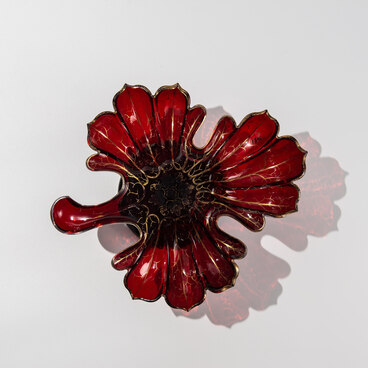The “Eiffel Tower” candlestick was made using the pressing technique in the early 20th century. Pressing is a precise, simple, efficient, and, therefore, cost-effective method of forming glass products. When the pressing technique is used, the images (facets) and their unique design are shaped using a mold when the glass mass is hot. There are both single-piece and split (multi-component) molds. They are made of metal and heated using a gas burner during the shaping process. The mold and the glass mass should be heated to approximately the same temperature to avoid cracks in the future. The glass mass is pressed at a temperature of around 1200 ºС. When the pressed item is hard enough, it is extracted by using a portable tray or by toppling the mold over and put into a lehr for annealing.
The first hand-operated mechanical pressing device was invented in England in 1826, and by 1838, it had been introduced at the Dyatkovo Crystal Factory, which was quite a unique industrial innovation for that time. At the turn of the 20th century, the factory was actively engaged in mechanizing the process of manufacturing household objects. The engineers tried to get rid of labor-intensive decoration techniques, and instead strove to introduce new, cheaper processing methods. The main requirements for such products were that they needed to be functional and practical. The Dyatkovo craftsmen put a lot of work into making the forms and decoration of mass-produced everyday objects more aesthetically pleasing. The factory started producing pressed glass and crystal items. The Dyatkovo Crystal Factory was the first Russian factory to master this type of products as early as in the 1830s and continuously developed this technique afterward. The technologists, engineers, and craftsmen conducted numerous tests at the Dyatkovo Crystal Factory to develop their own expressive means of pressed glassware.
This candlestick in the shape of the Eiffel Tower was made of light-blue glass using a four-part split mold. The light-blue color was obtained by adding a copper oxide into the glass batch. Depending on the concentration of copper compounds, glass composition, and painting conditions, such compounds can give the glass blue, light blue, green, or red color.
The first hand-operated mechanical pressing device was invented in England in 1826, and by 1838, it had been introduced at the Dyatkovo Crystal Factory, which was quite a unique industrial innovation for that time. At the turn of the 20th century, the factory was actively engaged in mechanizing the process of manufacturing household objects. The engineers tried to get rid of labor-intensive decoration techniques, and instead strove to introduce new, cheaper processing methods. The main requirements for such products were that they needed to be functional and practical. The Dyatkovo craftsmen put a lot of work into making the forms and decoration of mass-produced everyday objects more aesthetically pleasing. The factory started producing pressed glass and crystal items. The Dyatkovo Crystal Factory was the first Russian factory to master this type of products as early as in the 1830s and continuously developed this technique afterward. The technologists, engineers, and craftsmen conducted numerous tests at the Dyatkovo Crystal Factory to develop their own expressive means of pressed glassware.
This candlestick in the shape of the Eiffel Tower was made of light-blue glass using a four-part split mold. The light-blue color was obtained by adding a copper oxide into the glass batch. Depending on the concentration of copper compounds, glass composition, and painting conditions, such compounds can give the glass blue, light blue, green, or red color.


